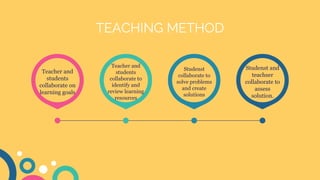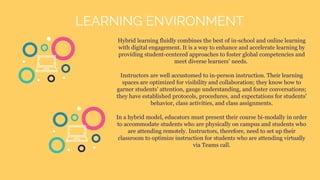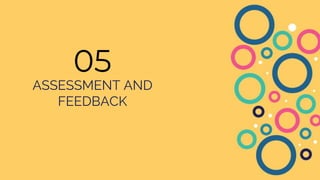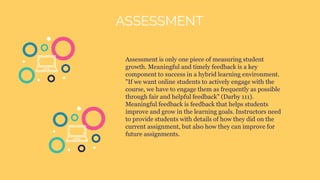Hybrid Learning
- 1. HYBRID LEARNING A new model for all future learning Created by: SWAPNA MITRA
- 4. Hybrid Learning is defined as integrated online instruction with traditional face to face class activities in a planned, pedagogically valuable manner.
- 5. Advantages Personalized Relevant Engaging With proper planning and lesson design hybrid model offers a flexible learning environment in which students and instructors work together to both design and carry out the learning experience.
- 6. TEACHING METHOD Teacher and students collaborate to identify and review learning resources Teacher and students collaborate on learning goals Studenst collaborate to solve problems and create solutions Studenst and teachser collaborate to assess solution.
- 7. ACTIVE PARTICIPATION OF STUDENTS LEADS TO ○ Critical Thinking ○ Creativity ○ Resilience ○ Independence ○ Self- Regulation ○ Cognitive Flexibility ○ Perseverence ○ Life Skills
- 8. TO CREATE RESILIENCE IN SCHOOL COLLABORATIVE CAPACITY BUILDING STANDARDIZE DIGITAL PLATFORM UTILIZE THE CHOOSEN DIGITAL PLATFORM FOR CHANGE MANAGEMENT
- 9. 5 ELEMENTS OF HYBRID LEARNING LEARNING ENVIRONMENT LESSON DESIGN CLASS COMMUNITY EMGAGEMENT AND INTERACTIVITY ASSESSMENT AND FEEDBACK
- 11. LEARNING ENVIRONMENT Hybrid learning fluidly combines the best of in-school and online learning with digital engagement. It is a way to enhance and accelerate learning by providing student-centered approaches to foster global competencies and meet diverse learners' needs. Instructors are well accustomed to in-person instruction. Their learning spaces are optimized for visibility and collaboration; they know how to garner students' attention, gauge understanding, and foster conversations; they have established protocols, procedures, and expectations for students' behavior, class activities, and class assignments. In a hybrid model, educators must present their course bi-modally in order to accommodate students who are physically on campus and students who are attending remotely. Instructors, therefore, need to set up their classroom to optimize instruction for students who are attending virtually via Teams call.
- 13. CLASS COMMUNITY Building a sense of community among students is crucial for every classroom or course section. Instructors can begin by posting an introductory video welcoming students to the virtual learning space and posting discussion prompts or hosting virtual social activities that help students learn more about their instructor and each other. Traditional ice-breaker activities conducted in-person will need to be revamped to develop connections with in- person and virtual students. Additionally, educators can create social channels for students to get to know each other, as well as establish routines and rituals in their class that students can look forward to and that can encourage students to participate in throughout the course. Finally, to create a strong community, student well-being must be at the forefront of hybrid environments. For younger students, educators can survey parents or guardians to learn about students' needs and how much adult guidance and support students will have when they work remotely. For older students, instructors can survey students about demands outside of school and other pressures that may interfere with their success in class. Instructors who show students they care and who genuinely work to help students in need will have students who are motivated and engaged in their course.
- 14. 03 LESSON DESIGN
- 15. QUESTIONS THAT ARISE BEFORE LESSON What will need to be covered in each lesson? What readings/videos will need to be shared? What practice activities, assignments, discussions will students need to complete? The background design process creates a rich learning experience for students and graduates that every activity, lesson and discussion instructors plan supports the enduring understanding.
- 16. LESSON DESIGN
- 17. INSTRUCTORS CAN ASK STUDENTS Share their thoughts, ask questions, answer questions Complete a quick form poll or practice forms quiz Process or practice a concept Discuss what they are learning with a partner Use a simple emoji in the chat window to demonstrate their comfort level with the material
- 18. Instructors need to use a variety of methods to help students see the purpose of what they are learning. Instructors can provide written instructions, video or audio announcements, and daily and/or weekly reminders about what the learning goals are. Within the multi-modal communications, instructors must reinforce the core objectives repeatedly. Moreover, to improve retention, educators will want to continually reinforce concepts by connecting what students learned yesterday to what they are learning today. Finally, to help students with structure and time management, instructors should plan to scaffold lessons and assignments. Providing students with smaller activities where they can practice skills and find success is one positive way to help prepare students for larger tasks that will be required in summative assessments.
- 20. Student engagement and interactivity is another element of hybrid learning. Instructors must consider how to keep students engaged synchronously and asynchronously. Additionally, educators need to present their course bi- modally for students who are physically on campus as well as students who are attending remotely. Educators need to invest in the live lecture experience to ensure that it is just as personal for the student joining remotely as it is for the student in the physical classroom. Instructors must work to ensure that all learners are active participants in the course rather than mere consumers.
- 21. Break students into small groups to solve problems, discuss concepts, or debate topics. Students joining remotely can work with students attending in-person to engage in the small group discussions. Provide students with hands-on activities that allow them to practice or visualize concepts. Be sure to use every day items that remote students have in their home so they will feel they can participate in the activity. Make sure to communicate the items they should collect and have at their remote learning workspace before class begins so students come prepared. If special items are required, create take home bags that students can pick up at a designated time. STRATEGIES Give students time to process and practice concepts individually. Be mindful about finding times within a class meeting to have students reflect on what they are hearing and practice what you are demonstrating.
- 22. Creating an @forms or Polly poll, a Pear Deck or Nearpod presentation, or a Kahoot or Quizlet activity and asking all students to participate Requiring everyone to reflect on a question, and not allowing anyone to raise their hand to answer the question until everyone (both in person and remote students) is showing a "thumbs-up." In-person students can physically indicate they are ready to move on with a thumbs up; remote students can add a thumbs up emoji in the chat window. Asking students to change their status to red if they are still working or they are having trouble with a concept and to change their status to green when they are finished working or feel confident with the concept. Remote students can change their statuses to busy for red and available for green; in-person students can use a notecard with a red dot on one side and a green dot on the other side and flip to the appropriate selection.
- 25. ASSESSMENT Assessment is only one piece of measuring student growth. Meaningful and timely feedback is a key component to success in a hybrid learning environment. "If we want online students to actively engage with the course, we have to engage them as frequently as possible through fair and helpful feedback" (Darby 111). Meaningful feedback is feedback that helps students improve and grow in the learning goals. Instructors need to provide students with details of how they did on the current assignment, but also how they can improve for future assignments.
- 26. ASSESSMENT To offer feedback effectively and efficiently, educators can use a number of strategies: Audio feedback in OneNote: Using Assignments in Microsoft Teams, instructors can distribute a OneNote page to students. When finished, educators can use the Insert Audio feature to offer feedback. Not only does audio feedback help instructors provide meaningful feedback in a timely manner, students report greater satisfaction when they receive audio feedback. According to Small Teaching Online, students "indicated an increased satisfaction with audio feedback; it felt more personal, they reported, and they found it to be more useful because the audio feedback included more explanation and suggestions for improvement than the written feedback did" (Darby 124). Notes in Forms Quizzes: Instructors can insert messages within a Forms practice quiz to provide feedback as the student completes the quiz. If the student answers incorrectly, the feedback feature in Forms can direct the student to a specific page or video that helps them find the answer to the question. If the student answers correctly, the feedback can send the student to a resource with additional information to challenge them further. Creating notes within the quiz allows instructors to be virtual tutors for their students as they practice concepts. Feedback cycles with Assignments in Teams: Instructors can create an assignment in Microsoft Teams, requiring students to submit their final work through the Team. Once submitted, educators can review students' work and provide feedback. When the feedback is returned to students, they can modify their work based on the instructors' feedback and resubmit.
- 27. FORMATIVE ASSESSMENT The goal of formative assessment is to gauge student progress throughout a unit of study. Formative assessments help students and instructors understand which concepts in which students need more practice to reach mastery. With formative assessment, students rely on feedback so they learn how to improve. Formative assessments encourage growth mindset and develop skills that students will be able to use throughout school and into the workforce.
- 28. FORMATIVE ASSESSMENT EXAMPLES Complete a poll, practice quiz, entrance/exit ticket in Forms Complete practice problems in OneNote Summarize their understanding of a video lesson or live lesson in OneNote Complete a graphic organizer using the Whiteboard app Answer questions related to a concept in Word.
- 29. SUMMTIVE ASSESSMENT Summative assessments are typically at the end of a unit of learning and measure students' mastery of the content. While formative assessment is not graded for accuracy and relies on instructor feedback, summative assessment is graded and final. Objective tests and essays are traditional summative assessments. Instructors can also utilize other assessment strategies to measure students' growth,
- 30. SUMMATIVE ASSESSMENT EXAMPLES Demonstrations: Instructors can task students with demonstrating their mastery of a concept by teaching it. Students can use Sway, PowerPoint, or Video Editor to teach an assigned topic to a specified audience. Students can also use Flipgrid or the Screen Recorder feature in PowerPoint or Stream to record themselves teaching a concept, explaining a process, or walking through the steps of how to solve a problem. Portfolios: Students can document their learning in OneNote. Students can reflect on their learning, self-assess, and provide authentic examples of their progress. At the end of the unit of learning, students can use their portfolio to write a response to an overarching essential question or respond to a Flipgrid prompt. Problem-based tasks: Instructors can give students or student groups real-world authentic problems to solve in a unit of learning. Throughout the course of study, educators would pose an authentic problem for students to solve and students would apply the content they are learning to the problem posed. Problem-based learning provides students with a purpose and engages them in meaningful work. Students feel a sense of responsibility, value, and independence when they focus on solutions to real- world questions.
- 31. OPPORTUNITY TO REIMAGINE EDUCATION 1. 2. 3. 6.4. 5. Connecting to purpose and meaning Challenging students to have high expectations Positioning learning goals that focus beyond the basics Using engaging pedagogies Building relationships and belongingness Providing opportunities to contribute to the world
- 32. 5 ELEMENTS
- 33. CREDITS: This presentation template was created by Slidesgo, including icons by Flaticon, and infographics & images by Freepik. THANKS! swapnamitra28@gmail.com swmitra28@gmail.com Please keep this slide for attribution.
































